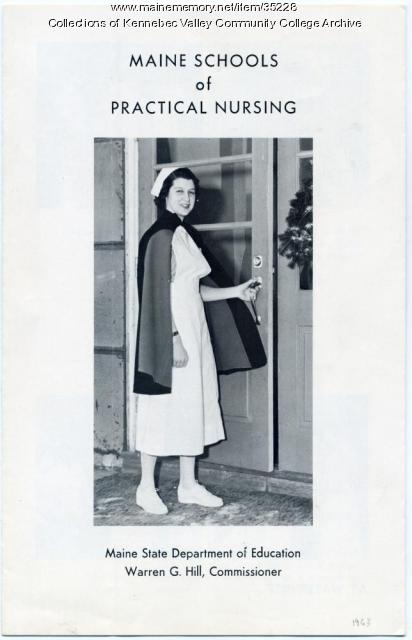Keywords: Educational publishing
Item 26409
Wording Hall, Ricker Classical Institute, Houlton, 1895
Contributed by: Mark & Emily Turner Memorial Library Date: 1895 Location: Houlton Media: Photographic print
Item 35228
Maine School of Practical Nursing Brochure, 1963
Contributed by: Kennebec Valley Community College Archive Date: 1963 Location: Waterville; Presque Isle Media: Ink on paper
Item 148189
Walch Publishing Valley Street alterations first floor plan, Portland, 1983-1987
Contributed by: Maine Historical Society Date: 1983–1987 Location: Portland Client: J. Weston Walch, Publisher Architect: Wadsworth Boston Mercer & Weatherill
Exhibit
Westbrook Seminary: Educating Women
Westbrook Seminary, built on Stevens Plain in 1831, was founded to educate young men and young women. Seminaries traditionally were a form of advanced secondary education. Westbrook Seminary served an important function in admitting women students, for whom education was less available in the early and mid nineteenth century.
Exhibit
Maine Streets: The Postcard View
Photographers from the Eastern Illustrating and Publishing Co. of Belfast traveled throughout the state, especially in small communities, taking images for postcards. Many of these images, taken in the first three decades of the twentieth century, capture Main Streets on the brink of modernity.
Site Page
"SEE NOTES "Jaffery" a new novel. Publisher's promotion postcard. Contributed by Farmington Public Library Description Publishers often…"
Site Page
"SEE NOTES "John Bunyon's Dream Story". Publishers promotional postcard. 1913. Contributed by Farmington Public Library Description…"
Story
Dr. Norman Beaupré: Preserving his Franco-American culture
by Biddeford Cultural & Heritage Center
Journey growing up as a Franco-American in Biddeford to his career as a professor and author.
Story
63 year Presque Isle High School Class Reunion
by Kathryn E Joy
What happens when there are no more reunions planned.
Lesson Plan
Grade Level: 3-5, 6-8, 9-12
Content Area: Social Studies, Visual & Performing Arts
"In the four quarters of the globe, who reads an American book?" Englishman Sydney Smith's 1820 sneer irked Americans, especially writers such as Irving, Cooper, Hawthorne, and Maine's John Neal, until Henry Wadsworth Longfellow's resounding popularity successfully rebuffed the question. The Bowdoin educated Portland native became the America's first superstar poet, paradoxically loved especially in Britain, even memorialized at Westminster Abbey. He achieved international celebrity with about forty books or translations to his credit between 1830 and 1884, and, like superstars today, his public craved pictures of him. His publishers consequently commissioned Longfellow's portrait more often than his family, and he sat for dozens of original paintings, drawings, and photos during his lifetime, as well as sculptures. Engravers and lithographers printed replicas of the originals as book frontispiece, as illustrations for magazine or newspaper articles, and as post cards or "cabinet" cards handed out to admirers, often autographed. After the poet's death, illustrators continued commercial production of his image for new editions of his writings and coloring books or games such as "Authors," and sculptors commemorated him with busts in Longfellow Schools or full-length figures in town squares. On the simple basis of quantity, the number of reproductions of the Maine native's image arguably marks him as the country's best-known nineteenth century writer. TEACHERS can use this presentation to discuss these themes in art, history, English, or humanities classes, or to lead into the following LESSON PLANS. The plans aim for any 9-12 high school studio art class, but they can also be used in any humanities course, such as literature or history. They can be adapted readily for grades 3-8 as well by modifying instructional language, evaluation rubrics, and targeted Maine Learning Results and by selecting materials for appropriate age level.














